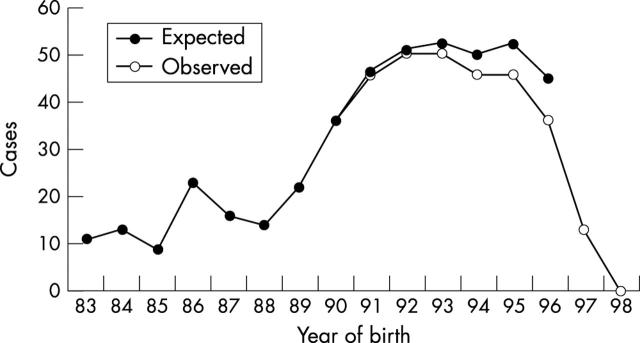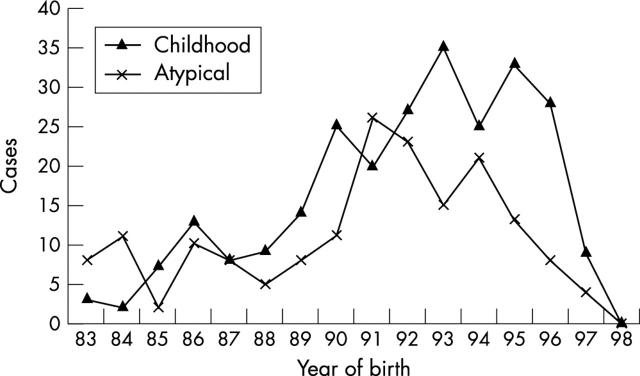Abstract
Background: The recorded prevalence of autistic spectrum disorders has risen over recent decades. Measles, mumps and rubella (MMR) vaccine has been blamed, by causing a "new variant" form of "regressive autism" associated with "autistic enterocolitis".
Aims: To estimate the prevalence of autism and to assess any changes in parental perception regarding the onset or causes of autism.
Methods and Results: A total of 567 children with autistic spectrum disorder in five districts in north east London were identified, born 1979–98. Reported autism, excluding the 94 cases of Asperger's syndrome, increased by year of birth until 1992, since when prevalence has plateaued. This flattening off persisted after allowing for expected delay in diagnosis in more recent birth cohorts. The age at diagnosis of autistic spectrum disorder was estimated to have decreased per five year period since 1983, by 8.7% for childhood autism and by 11.0% for atypical autism. There was some evidence that MMR was more likely to be mentioned as a trigger after August 1997 than before.
Conclusions: The prevalence of autism, which was apparently rising from 1979 to 1992, reached a plateau from 1992 to 1996 at a rate of some 2.6 per 1000 live births. This levelling off, together with the reducing age at diagnosis, suggests that the earlier recorded rise in prevalence was not a real increase but was likely due to factors such as increased recognition, a greater willingness on the part of educationalists and families to accept the diagnostic label, and better recording systems. The proportion of parents attributing their child's autism to MMR appears to have increased since August 1997.
Full Text
The Full Text of this article is available as a PDF (130.3 KB).
Figure 1 .
Observed and expected number of childhood or atypical autism cases diagnosed by the age of 10 years, by year of birth. (Expected number allows for the model estimate of the number of cases still to be diagnosed from 2000 onwards.)
Figure 2 .
Observed numbers of children with childhood and with atypical autism diagnosed by the age of 10 years, by year of birth.
Selected References
These references are in PubMed. This may not be the complete list of references from this article.
- Andrews N., Miller E., Taylor B., Lingam R., Simmons A., Stowe J., Waight P. Recall bias, MMR, and autism. Arch Dis Child. 2002 Dec;87(6):493–494. doi: 10.1136/adc.87.6.493. [DOI] [PMC free article] [PubMed] [Google Scholar]
- Baird G., Charman T., Baron-Cohen S., Cox A., Swettenham J., Wheelwright S., Drew A. A screening instrument for autism at 18 months of age: a 6-year follow-up study. J Am Acad Child Adolesc Psychiatry. 2000 Jun;39(6):694–702. doi: 10.1097/00004583-200006000-00007. [DOI] [PubMed] [Google Scholar]
- Chakrabarti S., Fombonne E. Pervasive developmental disorders in preschool children. JAMA. 2001 Jun 27;285(24):3093–3099. doi: 10.1001/jama.285.24.3093. [DOI] [PubMed] [Google Scholar]
- Davidovitch M., Glick L., Holtzman G., Tirosh E., Safir M. P. Developmental regression in autism: maternal perception. J Autism Dev Disord. 2000 Apr;30(2):113–119. doi: 10.1023/a:1005403421141. [DOI] [PubMed] [Google Scholar]
- Fombonne E. Is there an epidemic of autism? Pediatrics. 2001 Feb;107(2):411–412. doi: 10.1542/peds.107.2.411. [DOI] [PubMed] [Google Scholar]
- Gillberg C., Wing L. Autism: not an extremely rare disorder. Acta Psychiatr Scand. 1999 Jun;99(6):399–406. doi: 10.1111/j.1600-0447.1999.tb00984.x. [DOI] [PubMed] [Google Scholar]
- Taylor B., Miller E., Farrington C. P., Petropoulos M. C., Favot-Mayaud I., Li J., Waight P. A. Autism and measles, mumps, and rubella vaccine: no epidemiological evidence for a causal association. Lancet. 1999 Jun 12;353(9169):2026–2029. doi: 10.1016/s0140-6736(99)01239-8. [DOI] [PubMed] [Google Scholar]
- Taylor Brent, Miller Elizabeth, Lingam Raghu, Andrews Nick, Simmons Andrea, Stowe Julia. Measles, mumps, and rubella vaccination and bowel problems or developmental regression in children with autism: population study. BMJ. 2002 Feb 16;324(7334):393–396. doi: 10.1136/bmj.324.7334.393. [DOI] [PMC free article] [PubMed] [Google Scholar]
- Wakefield A. J., Murch S. H., Anthony A., Linnell J., Casson D. M., Malik M., Berelowitz M., Dhillon A. P., Thomson M. A., Harvey P. Ileal-lymphoid-nodular hyperplasia, non-specific colitis, and pervasive developmental disorder in children. Lancet. 1998 Feb 28;351(9103):637–641. doi: 10.1016/s0140-6736(97)11096-0. [DOI] [PubMed] [Google Scholar]




